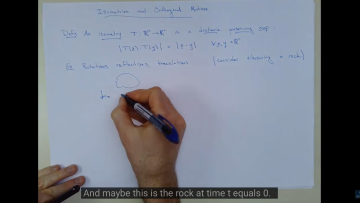3d N=4 theories on an elliptic curve
Abstract
I will discuss 3d N=4 supersymmetric gauge theories compactified on an elliptic curve, and how this set-up physically realises recent mathematical results on the equivariant elliptic cohomology of symplectic resolutions. In particular, I will describe the Berry connection for supersymmetric ground states, and in doing so connect the elliptic cohomology of the Higgs branch with spectral data of doubly periodic monopoles. I will show that boundary conditions, via a consideration of boundary ’t Hooft anomalies, naturally represent elliptic cohomology classes. Finally, if I have time, I will discuss mirror symmetry/symplectic duality in our framework, and physically recover concepts in elliptic cohomology such as the mother function, and the elliptic stable envelopes of Aganagic-Okounkov.
This talk will be based on https://arxiv.org/abs/2109.10907 with Mathew Bullimore.
Moduli space approach to the conjectures of Ivanov and Putman-Wieland
Abstract
A well-known conjecture of Ivanov states that mapping class groups of surfaces with genus at least 3 virtually do not surject onto the integers. Putman and Wieland reformulated this conjecture in terms of higher Prym representations of finite-index subgroups of mapping class groups. We show that the Putman-Wieland conjecture holds for geometrically uniform subgroups. Along the way we construct a cover S of the genus 2 surface such that the lifts of simple closed curves do not generate the rational homology of S. This is joint work with Markovic.
Group theoretic hyperbolicity and Dehn filling
Abstract
Group theoretic Dehn filling, motivated by Dehn filling in the theory of 3- manifolds, is a process of constructing quotients of a given group. This technique is usually applied to groups with certain negative curvature feature, for example word-hyperbolic groups, to construct exotic and useful examples of groups. In this talk, I will start by recalling the notion of word-hyperbolic groups, and then show that how group theoretic Dehn filling can be used to answer the Burnside Problem and questions about mapping class groups of surfaces.
Embedding subgroups into big mapping class groups
Abstract
A big mapping class group is the mapping class group (MCG) of a surface of infinite type. Although several aspects of big MCGs remain mysterious, their geometric definition allows some simple, interesting arguments. In this talk, we will use big MCGs as an excuse to survey some (more or less) classical results in geometric group theory: we will present a quick introduction to infinite type surfaces, highlight differences between standard and large MCGs, and use Higman’s embedding theorem to deduce that there exists a big MCG that contains every finitely presented group as a subgroup.
Signal processing on graphs and complexes
Abstract
We are confronted with signals defined on the nodes of a graph in many applications. Think for instance of a sensor network measuring temperature; or a social network, in which each person (node) has an opinion about a specific issue. Graph signal processing (GSP) tries to device appropriate tools to process such data by generalizing classical methods from signal processing of time-series and images -- such as smoothing, filtering and interpolation -- to signals defined on graphs. Typically, this involves leveraging the structure of the graph as encoded in the spectral properties of the graph Laplacian.
In other applications such as traffic network analysis, however, the signals of interest are naturally defined on the edges of a graph, rather than on the nodes. After a very brief recap of the central ideas of GSP, we examine why the standard tools from GSP may not be suitable for the analysis of such edge signals. More specifically, we discuss how the underlying notion of a 'smooth signal' inherited from (the typically considered variants of) the graph Laplacian are not suitable when dealing with edge signals that encode flows. To overcome this limitation we devise signal processing tools based on the Hodge-Laplacian and the associated discrete Hodge Theory for simplicial (and cellular) complexes. We discuss applications of these ideas for signal smoothing, semi-supervised and active learning for edge-flows on discrete (or discretized) spaces.
12:45
Scattering amplitudes and tropical Grassmannians
Abstract
The analytic structure of scattering amplitudes exhibit striking
properties that are not at all evident from the first principles of
Quantum Field Theory. These are often rich and powerful enough to be
considered as their defining features, and this makes the problem of
finding a set of universal rules a compelling one. I will review the
recently mounting evidence for the relevance of tropical Grassmannians
in this respect, including implications on symbol alphabets and
adjacency conditions
Scattering Amplitudes and Cluster Algebras
Abstract
In this talk we will study scattering amplitudes N=4 super-Yang-Mills theory. In this theory, scattering amplitudes are known to be functions of cluster variables of Gr(4,n) and certain algebraic functions of cluster variables. We will give an overview of how this cluster algebraic structure manifests, and will exploit it in an algorithm for computing symbol alphabets by solving matrix equations of the form C.Z = 0 associated with plabic graphs. These matrix equations associate functions on Gr(m,n) to parameterizations of certain cells of Gr_+ (k,n) indexed by plabic graphs. We are able to reproduce all known algebraic functions of cluster variables appearing in known symbol alphabets. We further show that it is possible to obtain all rational symbol letters (in fact all cluster variables) by solving C.Z = 0 if one allows C to be an arbitrary cluster parameterization of the top cell of Gr_+ (n-4,n).


